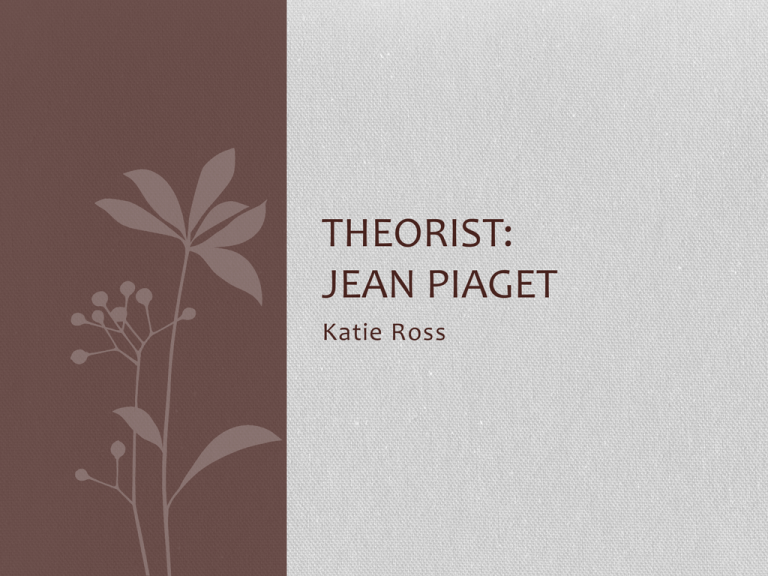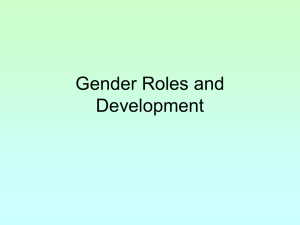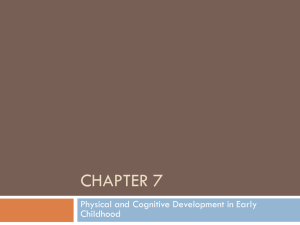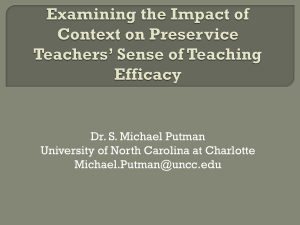Theorist: Jean Piaget
advertisement

THEORIST: JEAN PIAGET Katie Ross Background • • • • • • Born August 9, 1896 Died September 16, 1980 At a young age he became interested in research Earned his Ph. D in Zoology from the University of Neuchatel Developed his theories by studying the intellectual development of his own three children “Provided support for the idea that children think differently than adults.” References: http://psychology.about.com/od/profileso fmajorthinkers/p/piaget.htm THE FOUR STAGES OF COGNITIVE DEVELOPMENT Background Information About Piaget’s Theory Four Factors that Influence Changes in Thinking • Biological Maturation: The unfolding of the biological changes that are genetically programmed. • Activity: Acting on the environment and learning from it. • Social Experiences: Learning from others. • Equilibration: Search for mental balance between cognitive schemes and information from the environment. References: Woolfolk, 2010, p. 32 Two Basic Tendencies in Thinking Organization Adaptation • The combining, arranging, recombining, and rearranging of behaviors and thoughts into coherent systems.(Woolfolk, 2010, p. 32) • Piaget says humans are born with a tendency to organize thinking processes into psychological structures (these structures are for understanding and interacting with the world). (Woolfolk, 2010, p. 32) • These structures are schemes. • Piaget defines schemes as, organized patterns of thought and behavior used in particular situations (Papalia, 2009, p. 147) • Adjustment to the environment. (Woolfolk, 2010, p. 33) • Humans adapt by assimilation and accommodation in order to achieve equilibration. • Assimilation: Fitting new information into existing schemes • Accommodation: Altering existing schemes or creating new ones in response to new information. • Equilibration: Search for mental balance between cognitive schemes and information from the environment.(Woolfolk, 2010, p. 33) Importance of Equilibration • Piaget’s theory is based around this principle • “…the actual changes in thinking take place through the process of equilibration.” (Woolfolk, 2010, p. 33) • Process: • We relate a certain scheme to an event and it works, than it is in equilibration. If not, then disequilibrium occurs and this causes humans to search “for a solution assimilation and accommodation” therefore thinking changes. (Woolfolk, 2010, p. 33) The Four Stages of Cognitive Development Sensorimotor Stage • Infancy (age 0-2) • Infants learn, “about themselves and their world through their developing sensory and motor activity” (Papalia, 2009, p. 146) • Schemes remain tied to physical actions • Thinking at this stage involves: seeing, hearing, moving, touching, and asking • Accomplishments: • Ability to mentally represent objects and actions in memory • Start to recognize that objects still exist even if they are removed from sight • They move from reflex actions to goal-directed activity Preoperational Stage • Ages 2-7 • Tend to be egocentric • Egocentric: Assuming that others experience the world the same way they do (Woolfolk, 2010, p. 35) • Expansion of symbolic thought • Symbolic Thought: Ability to use mental representations (words, numbers, or images) to which a child has attached meaning (Papalia, 2009, p. 229) • Good at one way logic but have difficulty thinking backwards • Can do simple categorization • Difficulty with conservation and decentering • Conservation: Some characteristics of an object remain the same despite changes in appearance (Woolfolk, 2010, p. 35) • Decentering: Focusing on more than one aspect at a time (Woolfolk, 2010, p. 35) Concrete-Operational Stage • Ages 7-11 • Use reasoning to solve actual problems • Understanding of conservation, knowledge that things can change or be transformed and still conserve its original characteristics • Thinking is limited to real situations (the here and now), they cannot reason hypothetically or solve abstract problems • Education/Learning Affects: • • • • • Master classification Categorizes well Number and mathematics sense grow Understanding of maps, models, distance, and time grow Use only inductive reasoning Formal Operations • Ages 11 to Adulthood • Biggest part of this stage: Ability to think ABSTRACTLY! • Thinking shifts from what is, to what might be • Emotional Affects: • Adolescent Egocentrism- they know that others have different opinions and beliefs but are focused on their own ideas (Woolfolk, 2010, p. 39) • The possible and ideal start captivating the mind and feelings (Papalia, 2009, p. 372) • Education/Learning Affects: • Use symbols to represent other symbols (x stands for an unknown number), which is used in Algebra and Calculus • Better understand metaphor and allegory in Language Arts • Capable of hypothetical-deductive reasoning and inductive reasoning Cognitive Development in the Classroom • “There are at least two aspects of Piaget’s work that we believe are important parts of any course dealing with children’s learning and development: the logical problem developed by Piaget to demonstrate children’s thinking processes and the clinical method used to administer these problems.” (Ormrod, 1985, p. 216) • Educator’s can perform the clinical methods on students through already set-up logical problems to figure out what stage of development the child is at. • Different Experiments used: reverse seriation, conservation of substance, conservation of area, conservation of displaced volume, combinatorial logic, separation and control of variables, and proportional reasoning. (Ormrod, 1985, p. 216) Teaching Children at Different Levels Preoperational • Use props and visual aids • Make instructions as short as possible • Help students gain the ability to see things from another's point of view • Understand that students might have different meanings for the same word • Hands-on practice is a must • Provide a wide range of experiences to help build children’s schemas References: Woolfolk, 2010, p.36-38 Concrete-Operational • Use props and visual aids • Allow children to manipulate and test material • Instruction time needs to still remain brief and organized • When explaining complex ideas use familiar examples • Allow time for classification and grouping • Give children logical problems to think about and solve Formal Operations • “…only 30% to 40% of high school students can do Piaget’s formaloperational tasks” (as cited in Woolfolk, 2010, p.39) • It is questioned whether all adults ever get to this stage and at what age this occurs Fostering Formal-operational Thinking • Allow students to experiment • Allow them to think hypothetically • Teach broad concepts, not just specific facts and relate the material to their own life’s References: Woolfolk, 2010, p. 40 Bottom Line with Cognitive Development and Teaching • Piaget’s theory gives educators one way of figuring out how students think differently • A teacher needs to understand that they could and probably will have all types of learners, who are in different stages, trying to learn in their classroom • Materials need to be set up to benefit concrete thinkers but also formal thinkers • Instruction, tasks, and presentations need to be set up to satisfy all the levels of learners and thinkers • The Cognitive Development logical problems and clinical methods can be used by teachers as they plan • The specific teaching advice discussed previously can help teachers set up their instruction based on what age group they are teaching in order to provide the best education Teacher’s need to remember that there is no one size fits all education for all age groups! Younger children learn and think differently then older children! References Cherry, K. (n.d.). About.com: Psychology. Jean Piaget biography. Retrieved March 14, 2012, from http://psychology.about.com/ od/profilesofmajorthinkers /p/piaget.htm Ormrod, J.E., & Carter, K.R. (1985). Systematizing the piagetian clinical interview for classroom use [Electronic Version]. Teaching of Psychology, Vol. 12, No. 4, 216-219. Papalia, D.E., Olds, S.W., & Feldman, R.D. (2009). Human development (11 th ed.) New York: McGraw-Hill Companies. Woolfolk, A. (2010). Educational psychology (11 th ed.) New Jersey: Merrill, Pearson.










